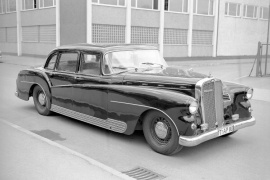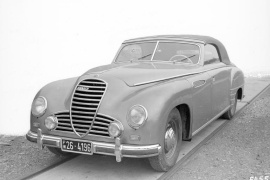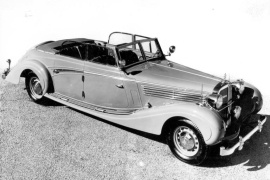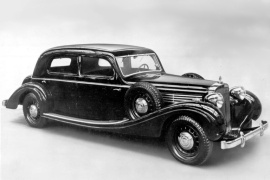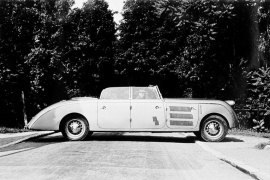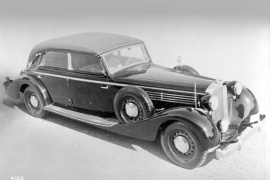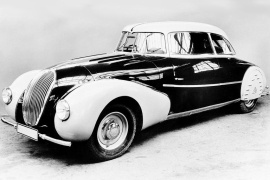MAYBACH Typ SW 35, SW 38 and SW 42 Models/Series Timeline, Specifications & Photos
First production year: 1935
Engines: Gasoline
Six years after the end of WWII, the German coachbuilder Spohn, together with what remained from the Maybach brand, tried to make a comeback on the market with a luxurious four-door sedan built for people with deep pockets.
After the war, Germany was in a very bad economic situation. Most automakers suffered from destruction or were banished from building vehicles. Since Maybach supplied engines for the German tanks and armored vehicles, it was targeted during the war, and its factory was destroyed. So, it tried together with Spohn to avoid sanctions. As a result, the coachbuilder took an old chassis, installed a 4.2-liter Maybach engine, and then made an exclusive bodywork to complete the package. The result is considered one of the best examples of German post-war designs and paved the way for the “Ponton” era.
The term refers to vehicles with narrow bodies and wide, curved front and rear fenders. Unlike vehicles made before the war, these were not as ample, but they looked slimmer and taller. The Maybach 42 Ponton by Spohn followed these principles, but the coachbuilder also let the imagination go beyond that and extended the front fenders toward the back of the car, resulting in a sloped down arched over the doors until the rear quarter panels. That elegant shape also inspired other automakers around the world in the following years. The tall and V-shaped engine compartment featured a flat radiator grille with a vertical center slat. It was protected by a single-piece chromed metallic bumper. The sloped-down rear end of the greenhouse was a reminder of the Stromlinen era, where Spohn made aerodynamically shaped vehicles. Finally, at the back, the long and curved trunk lid elegantly ended the vehicle. Since the vehicle was built on a chassis, the coachbuilder could offer it with either a standard wheelbase (SW) or an extended one (LWB).
Inside, the Spohn achieved a high level of craftsmanship and installed a flat dashboard with a wood finish adorned by chromed trims around the dials and gauges that formed the instrument cluster. These were not in front of the driver but moved towards the middle of the dashboard. The three-spoke steering wheel featured thin wires and expensive materials. For upholstery, Spohn allowed customers to choose from a wide category of materials, either fabrics or leather. Regardless of which wheelbase version the customer chose, they had plenty of legroom in the back, but the longer version allowed for rearward middle-row seating for translators.
Under the hood, Spohn installed the same 4.2-liter gasoline engine produced by Spohn before and during WWII, although with some slight adjustments for the improved gasoline that started to be available again after the 1939 premium gasoline crisis in Germany. The gearbox was a four-speed manual that allowed drivers to switch from third to fourth and back without using the clutch.
After the company's founder, Mr. Hermann Spohn, passed away in 1932, the company was led by his partner, Mr. Josef Eiwanger, who continued the work until 1950. Among other creations of this small shop, the 1948 Maybach SW 38 Ponton Cabriolet stood apart due to its look and engineering solutions.
In the aftermath of WWII, many car makers from Germany suffered from destruction, low production figures, or having the factories disassembled and moved abroad. Still, several small shops, such as the Spohn Karroserie Ravensburg, survived since they were not involved in war production. As a result, it continued doing whatever it knew best: creating artistic bodywork for customers. Mr. Eiwanger was still running the company when the chassis for this vehicle was brought. Before WWII, Spohn Karrosserie was responsible for creating most of the bodywork for Maybach, so it was the perfect shop to do the job.
Spohn focused on aerodynamic lines long before other mainstream automakers considered it essential for cars. That idea continued even after WWII, and the 1948 Maybach Typ SW 38 Ponton is no exception. The car featured a tall and tilted grille that dominated the front fascia. In addition, on the lower side, there were two additional, wing-like air intakes. The wide wheel fenders sat lower than the vehicle's hood, reminiscent of the pre-war styling. Still, they were flush with the doors and the rest of the bodywork, which was not a typical design for that era. Behind the front wheels, the coachbuilder concealed the spare wheels behind the body panels. Moreover, the door handles were pressed into the panels to create an even more streamlined shape. Yet, at the back, the fenders were slightly larger than the rest of the bodywork to create a muscular look. Finally, the sloped-down trunk lid allowed for a smoother flow of air. Since the SW 38 featured a short wheelbase and cabin, the bodywork specialist installed a retractable canvas top without side rear windows. Still, there was a windscreen in the back.
Inside, Spohn Karrosserie used black leather to wrap the interior. At the front, there was a pair of seats, while in the back, a small bench seat allowed for two more passengers, although there was limited legroom there. The Typ SW 38 featured the same instrument panel carried over from the regular Maybach models on the dashboard since it came with the rest of the chassis.
Before WWII, Maybach had to increase the engine size for its vehicles from 3.8-liter to 4.2-liter to compensate for the low-quality gasoline available. After WWII, that restriction on higher quality fuel was lifted, so the inline-six powerplant had the same displacement as before, of 3.8-liter. Since Maybach was also an expert on building transmissions, it made a four-speed semi-automatic gearbox, where the clutch had to be used only on departure and the first three gears.
When WWII started, most carmakers had to adapt to new conditions, but Maybach considered that they had a mission to fulfill, and that was to produce exclusive vehicles.
With the SW 42 range introduced in 1939, the German automaker tried to attract orders from its country's government. Unfortunately for it, though, Mercedes-Benz was the preferred carmaker by the Third Reich, so Maybach had to rely only on a few rich customers. Moreover, while most of the cars were bodied by other coachmakers, such as Spohn or Vysoke Myto, it also offered a Maybach-branded body, which was not that advanced in its look but spotless in terms of quality.
The SW 42 Cabriolet shared the same front side with its sedan sibling. It featured valanced, long front fenders that emerged into the side steps towards the rear quarter panels. The body-on-frame construction allowed for a four-door open-top bodywork with removable side windows. Its retractable canvas roof was folded neatly behind the rear passengers, and it could have been completely removed for a sleeker look of the car. The front, rear-hinged doors allowed the driver and side occupant to quickly egress from the car and open the rear, front-hinged ones for the passengers.
Inside, the leather-wrapped cabin sported wide bucket seats at the front and a comfortable rear bench, wide enough to fit three people. As a luxury feature, the rear passengers had access to a cabinet with drawers and doors where they could store bottles, glasses, or picnic baskets.
Under the hood, the carmaker installed the 4.2-liter powerplant that, due to the reduced compression ratio, provided just 138 hp (140 PS). It was mated to a four-speed manual gearbox that didn't require a clutch to shift from third to fourth gear.
The Maybach SW series included numerous versions of vehicles, including coupes, convertibles, and limousines. They shared the same chassis, but with different wheelbases. And some were very rare, such as the model 42.
WWII already started in 1939 when the first SW42 rolled out from the factory, but it was the same as before: the chassis was built by Maybach and then the bodywork was supplied by other companies such as Glass, Spohn, or Vysoke Myto in Slovakia. The last vehicle built over an empty SW42 chassis is believed to be the Erdman&Rossi in 1949 for an East Germany official.
The main idea of the time was that a custom-built needs to be done by special workshops and the chassis, drivetrain, and engine to be built by another workshop. From the 133 chassis built by Maybach for the SW42, The main difference between the SW38 and the SW42 was the engine displacement. Due to the shortage of better fuel, which was used by the German Army, the car-manufacturer had to lower the compression ratio up to 6.6:1, instead of the regular 8:1. Due to that, the power output dropped. But Maybach didn't want its cars to be sluggish and slow. With the increase, it obtained the same 140 hp from the straight-six unit. The carburetors were also modified for the lower-quality fuel.
The interior of the Maybach 42, regardless of the bodywork, was built with high-quality materials. An interesting quality of the vehicles, especially for those built by Spohn, was that they featured electrically operated windows.
Maybach was not in its best financial situation after the Great Depression, and it tried to attract deep-pocket customers with the SW 35/38 lineup and custom-made bodyworks made by Spohn.
Like many other automakers from that era, Maybach offered its vehicles fitted either with its own range of bodyworks or other ones supplied by various coachbuilders. For this German automaker, Spohn was the preferred one not only because it knew all the whatnots of the vehicle but also because its engineers did an excellent job. After all, Maybach was a luxurious brand, and nothing could tell more about that than a stunning look.
The coachbuilder created the Streamlined (Stromlinien) shape for big vehicles so they could easier cut through the air. These were the most aerodynamic products made by Spohn. For the SW 35/38, the coachbuilder redesigned the front fascia, thus replacing the straight and vertical radiator installed by the carmaker. It added a tilted-back, curved panel. Its long and curved front fenders sported the headlights, which were enclosed in tear-shaped cases. From its profile, the long vehicle featured flat side panels that made the air go smoother on the sides, towards the sloped-down rear end. Unlike the regular Maybach, the Spohn version's doors were hinged on the B-post. Another particular aspect of this open-top luxurious vehicle was the fully retractable canvas, which could've been completely concealed behind the cabin.
Thanks to its large cabin, the SW 38 Stromlinien provided a great level of comfort for the occupants. Expensive materials and excellent craftsmanship were also included.
Since Germany was preparing for war, high-grade gasoline had become scarce at that time. Thus, the formerly used 3.5-liter inline six had to be bored and increased to a 3.8-liter displacement so customers didn't feel a drop in the power output.
Maybach was struggling to survive in the luxury market segment where Mercedes-Benz started to increase its presence, and the German carmaker developed the SW 35 lineup to survive.
With the German economy starting to rise again after the Great Depression, Maybach saw this opportunity to launch a new range of vehicles. Like its main competitor, Mercedes-Benz, it created a new chassis and a new drivetrain and offered it in various shapes and sizes.
The SW35/38 came with a typical design for those times. Unlike Mercedes-Benz, which placed the car's headlights on a curved cross-beam between the front fenders, Maybach mounted the headlamps onto the sides of the engine compartment. Thus, they could leave the front of the radiator completely exposed, helping the cooling system. Also, the chromed rim of the radiator and the vertical slats were easier to see and looked different from other luxury brands from that era. Still, they had to stick with the curved, long wheel fenders interrupted only by the side-mounted spare wheels, one on each side of the car. The long slope from these went all the way to the rear fenders, which were also wider than the cabin. Fitting four doors on the vehicle was not easy for an open-top bodywork, but they made that by mounting the hinges on the B-pillar.
With a cabin fit for kings, the Maybach SW35/38 offered enough legroom for all four occupants. Thanks to the front-hinged rear doors, the driver could quickly open them as soon as the car stopped. Its passengers could easily step down from the vehicle with the aid of the bars mounted on the seatbacks of the front seats. Moreover, they could roll down the side windows.
Under the hood, Maybach started the lineup with the 3.5-liter engine, but when the higher-grade fuels became scarce and reserved mostly for the army, the carmaker increased the engine displacement to 3.8-liter, so the cars could provide the same power.
Just a few years before WWII blew the world into pieces, Maybach built few very special models and chose the Spohn coachbuilder to build some of its extraordinary vehicles. The unusual result was the Stromlinien.
The Stromlinien (eng. Streamline) was one of the few cars in that era that tried to take the aerodynamic into account. The design was unusual and it was designed by Paul Jaray, who was known for the creation of that drop-shaped greenhouse. But more unusual was the windshield, which was wrapped around the front cabin. The middle section could have been open, for more fresh air.
The body was made on top of an SW 35 chassis, which also had some unusual features. In those times, most of the cars had front and rear solid axles with leaf springs. The SW 35 had a double-wishbone front suspension. Spohn built two such vehicles, one of which was exhibited at the German International Motor Show in 1935. The curved chassis was another characteristic of the vehicle, and that technical solution allowed a lower center of gravity.
The 3.5-liter engine was supplied by Maybach. It was considered a better option due to its very good power to weight ratio. It was a better fit under the hood. In the end, all of the innovations in the car paid off and the SW 35 Stromlinien had a higher top speed when compared with the regular SW 35 with the same engine by 20 kph (12.5 mph). It might not seem much, but it was 1935.
After the Great Depression, Germany started to get back on its feet, and Maybach struggled to survive in a market segment dominated by Mercedes-Benz. Still, it didn't want to give up.
Unlike its main competitor, Maybach didn't know how to build affordable cars. Unlike Mercedes-Benz, which created new cars from scratch, it tried to make the same big, imposing vehicles but fitted with smaller engines. The Typ SW35/SW38 was developed just after the Great Depression and was created as a luxury car with an inline-six under the hood.
Maybach already had its way of creating cars and applied them to the new model. It mounted the headlights on top of the curved, wide fenders that flanked the engine compartment. Thus, it cleared the cooling area in front of the radiator. Just like other Maybach products, this one featured an imposing tilted and slightly V-shaped grille-mounted behind the chassis's endings, so it could be protected. Behind the curved fenders, the manufacturer mounted the spare wheels, one on each side of the vehicle. Depending on the customer's specifications, it could install rear-hinged or front-hinged front doors while the rear ones were rear-hinged. Thus, when both doors were opened, they created a vast area between the A- and C-pillars. It was a daring innovation, but since the SW35/SW38 was built on top of a chassis, it did work.
The cabin was luxurious, boasting a full leather-wrapped interior. Its front bucket seas were wide and sported grab-handles behind their seatbacks. That helped the rear occupants with their ingress and egress from the vehicle.
Unfortunately, the weak 3.5-liter engine produced just a mere 140 PS (138 hp), and it was paired to a four-speed manual gearbox plus overdrive. After Germany decided to decrease the fuel quality on the market, Maybach increased the engine's displacement to 3.8-liter to not lose power.
